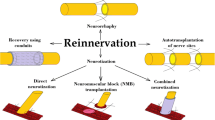Summary
In nine selected cases a primary nerve repair was done. In all these patients a special suture was used. Applying clinical and neurophysiological tests, regeneration of the motor and sensory nerve fibres was followed for two years.
A remarkable difference in growth rates of sensory and motor nerve fibres was observed. The average rate of growth of sensory nerve fibres was 5 mm a day, and of motor nerve fibres it was 1.7 mm a day. At the end of a two years' interval after operation, good recovery from the initial muscular atrophy was observed in all but two cases. Function of previously denervated muscles was nearly normal. Discrimination of points 4–10 mm apart was possible. Normal terminal conduction times along motor nerve fibres were found in five eases. Slightly prolonged times were found in four. Calculated conduction velocities in sensory nerve fibres were half to three quarters of normal times.
All patients resumed their previous occupations.
Similar content being viewed by others
References
Brown, P. W., Symposium on operative nerve injuries and their repair. The Surgical Clinics of North America.52 (1972), 1097–1355.
Dolenc, V., Mehanizmi senzorično-motorične integracije v normalnem in obolelem živčevju človeka. Letno poročilo. Institut za klinično nevrofiziologijo, Ljubljana (1974), 1–8.
Ducker, T. B., Hayes, G. J., Experimental improvement in the use of silastic cuff for peripheral nerve repair. J. Neurosurg.28 (1968), 582–587.
Guth, L., Regeneration in the mammalian peripheral nervous system. Physiol. Rev.36 (1956), 441–478.
Gutmann, E., Sanders, F. K., Recovery of fibre numbers and diameters in the regeneration of peripheral nerves. J. Physiol., Lond.101 (1942), 489–518.
Kline, D. G., Hayes, G. J., The use of a resorbable wrapper for peripheralnerve repair. Experimental studies in chimpanzees. J. Neurosurg.21 (1964), 737–750.
Nicholson, O. R., Seddon, H. J., Nerve repair in civil practice: Results of treatment of median and ulnar nerve lesions. Brit. Med. J.2 (1957), 1065–1071.
Peacock, E. E. Jr., Van Winkle, W., Surgery and Biology of Wound Repair. Philadelphia: Saunders. 1970.
Seddon, H. J., Medawar, P. B., Smith, H., Rate of regeneration of peripheral nerves in man. J. Physiol., Lond.102 (1943), 191.
Snyder, C. C., Webster, H. Def., Pickens, J. E., Hines, W. A., Warden, G., Intraneural Neurorrhaphy. Ann. Surg.167 (1968), 691–696.
Sunderland, S., Nerves and nerve injuries. Edinburgh: E. and S. Livingstone. 1968.
—, Bradley, K. C., The cross-sectional area of peripheral nerve trunks devoted to nerve fibres. Brain72 (1949), 428.
Weiss, P., The technology of nerve regeneration: a review. Sutureless tubulation and related methods of nerve repair. J. Neurosurg.1 (1944), 400–450.
Author information
Authors and Affiliations
Rights and permissions
About this article
Cite this article
Dolenc, V., Janko, M. Nerve regeneration following primary repair. Acta neurochir 34, 223–234 (1976). https://doi.org/10.1007/BF01405877
Issue Date:
DOI: https://doi.org/10.1007/BF01405877




